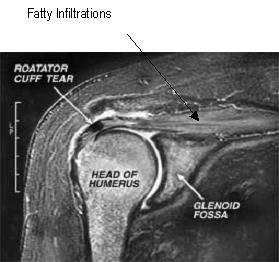Supraspinatus Tear + Fatty Infiltrations = Poor Surgical Outcome
Reference:Barry JJ, et al The relationship between tear severity, fatty infiltration, and muscle atrophy in the supraspinatus. J Shoulder Elbow Surg. 2013 Jan;22(1):18-25.
Many studies have shown atrophy and the presence of fatty infiltration within the rotator cuff muscles in individuals post rotator cuff tears. The problem is that fatty infiltrations have been shown to be predictive of poorer functional outcomes after surgical repair.
In this 2013 study 377 patients with shoulder pain received an MRI and of those 30% had full-thickness tears of the supraspinatus, 40% had partial thickness tears, and 30% had no evidence of a tear.
As anticipated they found a positive correlation between the severity of cuff tear and the degree of fatty infiltrations and age.
Clinical Relevance: Even if there is a partial tear, every attempt must be made to strengthen the rotator cuff muscles to avoid the invasion of the evil fatty infiltrations, as they are unfortunately predictive of poor surgical outcomes.
If there is a full thickness tear and the person is young, surgical repair should be considered as soon as possible. The longer time goes by, the more the fatty infiltrations will invade the supraspinatus muscle. Regrettably strengthening is not possible if the tendon is fully ruptured!
Posted on: March 23, 2013
Categories: Shoulder


